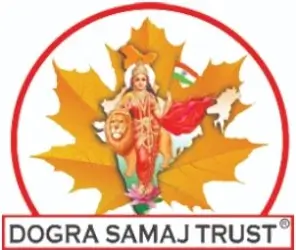Omachanda Handa believes that the Durgara people were originally migrants from Rajasthan. The allusion to durg (fort) in their name indicates that they may have remained a warrior people, eventually founding powerful kingdoms between Chenab and Ravi, and possibly dominating up to the Sutluj river.
According to archaeologist M. A. Stein, there were some eleven Dogra states in the region, all of them eventually absorbed into the Jammu state, which emerged as the most powerful. Prior to the rise of Jammu, Babbapura (Babor) is believed to have been the chief state of Dogras. Lying 45 km east of Jammu, Babor contains the ruins of six magnificent temples representing a “thriving artistic activity”. The Rajatarangini mentions Raja Vajradhara of Babbapura vowing allegiance to Bhikshachara of Kashmir in 1120 AD, along with the chiefs of neighbouring kingdoms.
Jammu Dogras
The Jammu Dogras traditionally inhabited the area between the slopes of the Shivalik range of mountains and the sacred Surinsar Lake and Mansar Lake, but later spread over whole of the Jammu region. Many of the dogras immigrated from the state of Punjab, specifically from Sialkot region. They generally speak Dogri and other dialects similar to Dogri or western Pahadi-influenced languages. The majority of the Dogra are followers of Hinduism, but many in Jammu and Kashmir believe in other religions. In the sixteenth and seventeenth centuries, some Dogras embraced Islam and Sikhism. These factors, together with the effects of immigration into the region, have resulted in the Dogra population of Jammu and Kashmir including members of all three religions.
The Dogra dynasty emerged as a regional power, particularly after Rajput Maharaja Gulab Singh emerged as a warrior and his subjects received special martial recognition from the British Raj. The rule of Gulab Singh’s Raj extended over the whole of the Jammu region, a large part of the Ladakh region as early as March 1846, and a large part of the Indian Punjab (now Himachal Pradesh). The Kashmir Valley was handed over to Gulab Singh by the British government, as part of the territories ceded to the British government by Lahore State according to the provisions of Article IV of the Treaty of Lahore dated 9 March 1846. Under the Treaty of Amritsar in the same year, the Dogra king of Jammu and the state was thereafter known as the Maharaja of Jammu and Kashmir State (Raj), also thereafter referred as Kashmir State. The term Dogra hence is more akin to the subjects of Himachal Pradesh, some areas of Punjab and the whole region of Jammu that was ruled by Raja Gulab Singh as part of the Dogra Raj irrespective of the religion of the inhabitants.
Jammu and Kashmir
The Dogra dynasty was a dynasty of Hindu Rajputs who ruled Jammu & Kashmir from 1846 to 1947. They traced their ancestry to the Ikshvaku (Solar) Dynasty of Northern India (the same clan in which Lord Rama was born; he, therefore, is the ‘kuldevta’ (family deity) of the Dogras).
The Sikh Empire rule extended beyond the Jammu region and the Kashmir Valley to the Tibetan Buddhist Kingdom of Ladakh and the Emirates of Hunza, Gilgit and Nagar. After the First Anglo-Sikh War in 1846, the British gave Kashmir and the title of ‘Maharaja’ to Gulab Singh.
Military History
The Dogra Regiment was among the regiments of the British Indian Army, which made significant contributions in both the world wars on all fronts from East Asia to Europe and North Africa. At Independence, it became an infantry regiment of the Indian Army composed largely but not exclusively of the Dogra people. The Jammu and Kashmir Rifles, another regiment of the Indian Army, consisting of mainly Dogras was formed out of the former army of the Kingdom of Jammu & Kashmir after it was absorbed into the Indian Army

